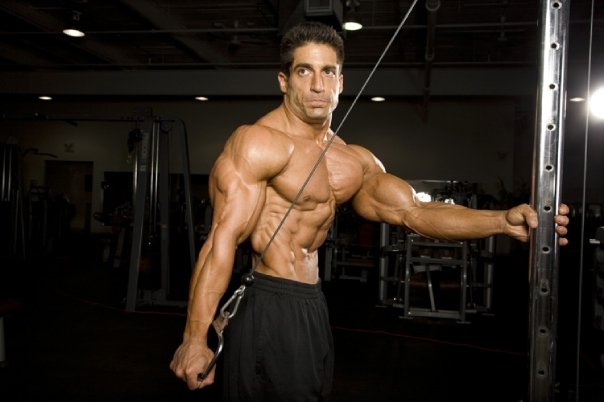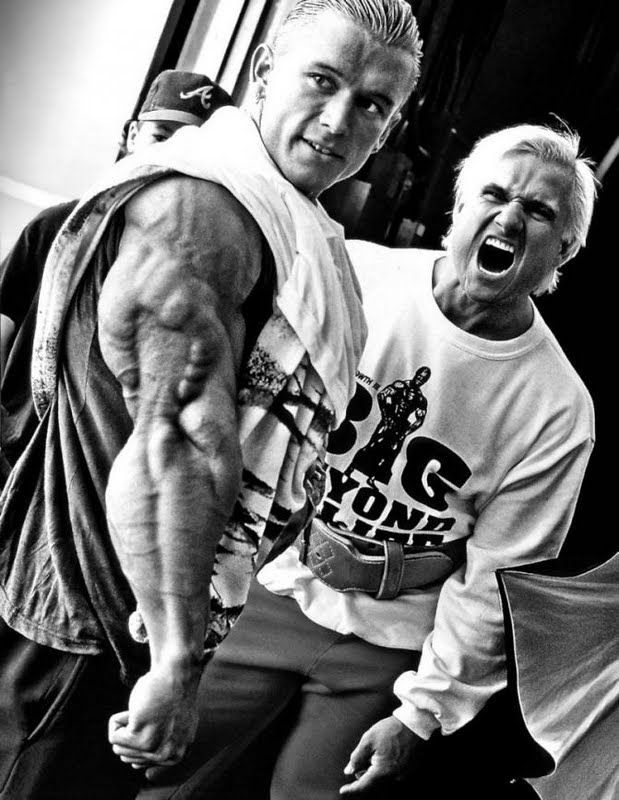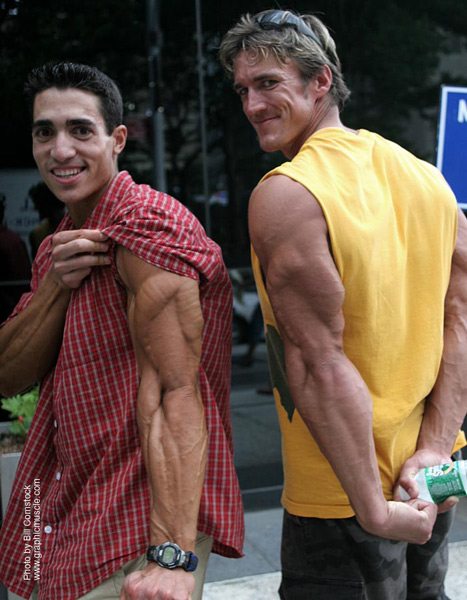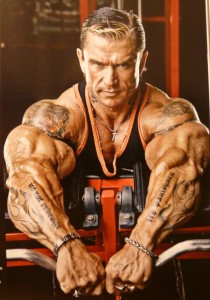Triceps are like the big brother with a blue-collar job, toiling in anonymity, carrying their own workload and assisting others (chest and shoulders). All the while, they’re overshadowed by their little brother biceps the star athlete who grabs more attention without working as hard (assisting only back). The key to this analogy is that tri’s are the bigger muscles, despite their lagging reputation. In this article, we tackle the five most common triceps blunders and lay out a course for raising your tri’s to star status.

#1 Not stressing all three heads
As the name suggests, your triceps have three heads: long (upper inside), medial (lower inside) and lateral (outside). The heads always work together, so it’s impossible to isolate one from the others. However, the angle of your arms changes the emphasis, stressing the heads differently. Too many bodybuilders are unaware of how various exercises hit their tri’s, and thus they typically overemphasize their lateral heads and underemphasize the long and medial heads.
Solutions
- When your arms are straight by your sides with an overhand or a parallel grip (palms facing each other, also known as a neutral grip), the lateral heads are worked most, as during conventional pushdowns.
- When your arms are straight by your sides with an underhand grip, the medial heads are hit most. Regardless of hand position, the medial heads also assist more on all triceps lifts as the arms reach full extension. To give your medial heads their due, consider adding reverse-grip pushdowns to your routine, and always squeeze out full contractions on triceps exercises.
- When your elbows are moved in front of your body or overhead, the long heads are targeted. Overhead extensions are best for “going long,” so always include some form of overhead tri extension in your routine.

#2 Inefficient exercise order
No exercise order is incorrect, but some are less efficient. Changing the order can shock your tri’s, and at times you may want to pre-exhaust by doing, say, pushdowns before close-grip benches. However, begin most workouts with the exercises in which you can overload your tri’s with the greatest resistance. Do those first in your routine because that’s when you’re strongest.
Solutions
- Do compound lifts, such as dips or close-grip bench presses, first.
- Do two-arm, free-weight extensions next.
- Finish with unilateral (one-arm) or cable exercises.
- You can change the preceding order on occasion, but stick to it for most tri workouts.
#3 Focusing too much on machines and cables
 Many trainers rely too heavily on various pushdowns and cable extensions. For example, it’s not uncommon for bodybuilders to include four sets of both V-bar and rope pushdowns in the same workout, but these similar exercises stress the triceps in nearly identical ways, emphasizing the lateral heads.
Many trainers rely too heavily on various pushdowns and cable extensions. For example, it’s not uncommon for bodybuilders to include four sets of both V-bar and rope pushdowns in the same workout, but these similar exercises stress the triceps in nearly identical ways, emphasizing the lateral heads.
Solutions
- Do a compound exercise (one that also involves the chest and shoulders) in each tri workout. Examples include close-grip bench presses, upright dips and bench dips with your hands behind your back.
- Do at least one EZ-curl bar or dumbbell extension in each tri workout. Examples include lying EZ-curl bar triceps extensions, two-arm dumbbell overhead extensions and one-arm dumbbell overhead extensions.
- If you do two pushdown exercises, one should be done with an overhand or parallel grip (to emphasize the lateral heads) and the other should be underhand (to emphasize the medial heads).
#4 Improper form
To focus the stress on your triceps, you need to keep your elbows locked in place. The moment you start moving your elbows forward, backward or outward, you shift some emphasis to your shoulders. Doing so allows you to use more weight or crank out more reps, but if you turn tri exercises into partial pullovers, you’re making it easier on your triceps when you should be making it harder.
Solutions
- Lock your elbows in place for all reps until you reach failure. For pushdowns this is easy to do by pressing your elbows against your sides and not allowing them to deviate from that position.
- After reaching failure with strict reps, you can then loosen your form to eke out a few more reps. Do this by moving your elbows forward during the negative half of the rep and backward during the positive half. Cheat as little as you must to keep the set going.
#5 Overtraining
 Out of all your bodyparts, triceps are the most prone to overtraining. This is in part because most bodybuilders know the tri’s are larger than the bi’s, and in their quest for higher-caliber guns, they assume that if they do 12 sets for bi’s they should crank out 18 for tri’s. Also–unlike your bi’s, which help only during back workouts–your tri’s help when you train chest (pressing movements or dips) and shoulders (pressing movements). If you train chest, shoulders and triceps on different days, they’re getting a triple whammy, likely without enough time to recuperate between workouts.
Out of all your bodyparts, triceps are the most prone to overtraining. This is in part because most bodybuilders know the tri’s are larger than the bi’s, and in their quest for higher-caliber guns, they assume that if they do 12 sets for bi’s they should crank out 18 for tri’s. Also–unlike your bi’s, which help only during back workouts–your tri’s help when you train chest (pressing movements or dips) and shoulders (pressing movements). If you train chest, shoulders and triceps on different days, they’re getting a triple whammy, likely without enough time to recuperate between workouts.
Solutions
- Triceps are relatively small muscles. Generally, 12 sets will suffice. If you do chest or shoulder pressing exercises earlier in the same workout, consider doing even fewer sets because your tri’s get some work locking out presses.
- Rest a minimum of 48 hours and ideally at least 72 hours between training chest or shoulders and training triceps. Arrange your workout split accordingly.
Lessons Learned
- Do exercises in each triceps workout that emphasize the long, lateral and medial heads.
- Generally, do compound lifts first, two-hand free-weight lifts next and finish with one-arm or cable exercises.
- Include free-weight exercises in each tri workout.
- Lock your elbows in place until you reach strict-rep failure.
- Typically, do no more than 12 sets per triceps workout, and always rest at least two days between training chest or shoulders and training tri’s.
Author: Greg Merritt, Senior Writer of Flex Magazine
References:
COPYRIGHT 2004 Weider Publications
COPYRIGHT 2008 Gale, Cengage Learning
Flex Magazine
www.findarticles.com
www.flexonline.com










